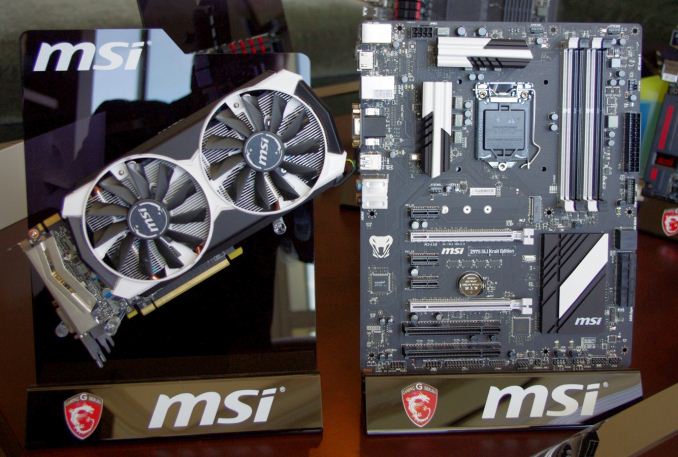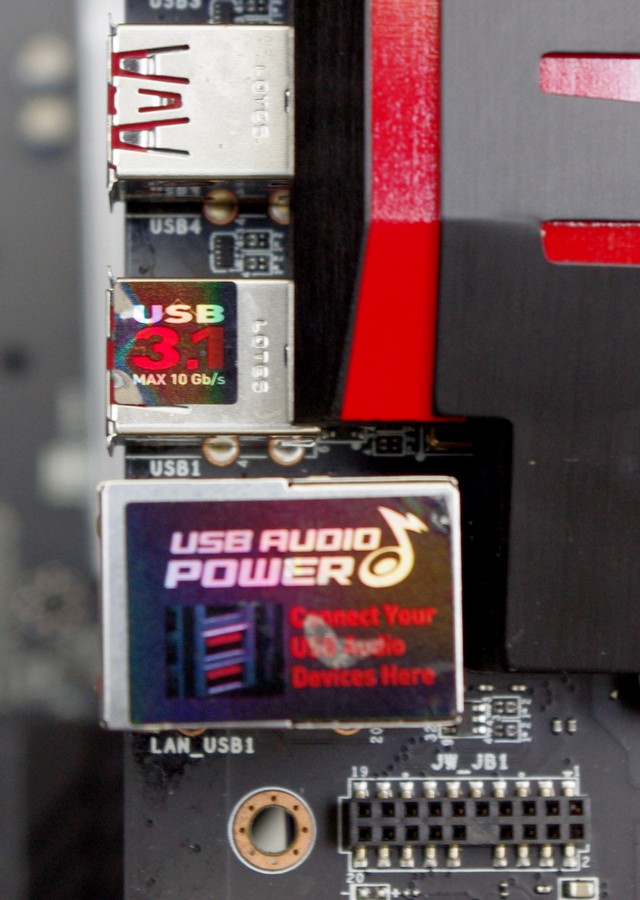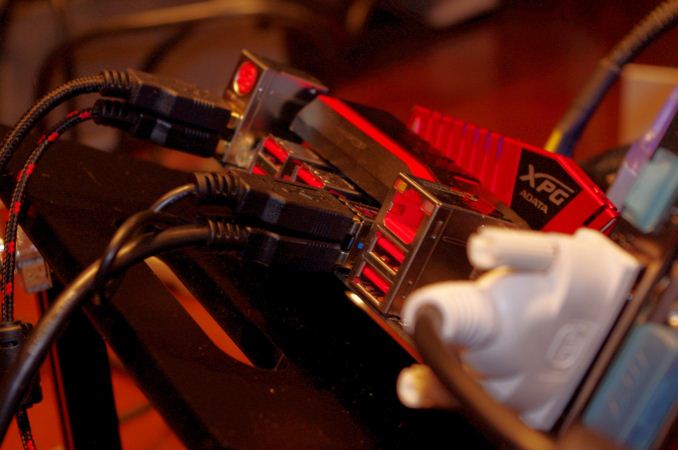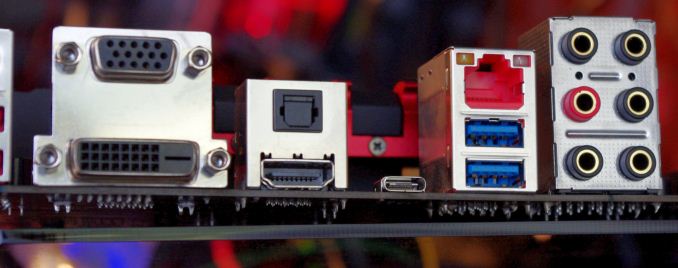MSI Goes USB 3.1 at CES 2015: The MSI Component Suite Tour
by Ian Cutress on January 12, 2015 2:00 PM EST
Back at Computex we reported that MSI was showing a potential mock-up of USB 3.1 on one of their motherboards. Fast forward a few months and this is slowly becoming a reality, with working silicon and demos on hand, almost ready to ship. USB 3.1 is set to be used in two different standards: the USB Type-A connector that we are all familiar with (and get frustrated when it never goes in first time) and the Type-C reversible connector that is being pushed and marketed as the next USB connector standard. MSI had motherboards showing both on display.
The working model for USB 3.1 that MSI had at the suite involved the Type-A connectors connected to a special 3.1-to-RAID device which was kept under wraps due to NDA or other reasons. There will be a number of USB 3.1 controllers available for motherboard manufacturers to use until it comes part of the chipset, but MSI told us that companies like ASMedia and VIA are the usual sources for this and both are being considered right now. The controller being used by MSI gave two ports and uses two PCIe 2.0 lanes, meaning that the total bandwidth between the two ports would be 10 Gbps. For this demo these two ports were being used as one for data and one to power the device in the box.
A word about the power – while the USB 3.1 specifications should allow 100W in quick charge mode, it is up to the manufacturer to support this. Having 100W going through the motherboard at the rear panel will need to design the extra circuitry in order to provide that power, which has an associated PCB area and monetary cost. At this point in time, I do not see the maximum power delivery option going to be on many (if any) solutions both in desktop and notebooks unless it is a super high end product. It will more likely end up with the plug-in-the-wall to USB adapters that are supplied with notebooks.
Nevertheless, the USB 3.1 setup which we were told used two 128GB Intel 530 SSDs in RAID-0 showed performance better than that of a single SATA 6 Gbps port. As shown in the image above, 600+ MB/s is possible with the right hardware on the other end, which leads to another potential issue with USB 3.1. The devices that can take advantage of USB 3.1 data transfer are most likely going to be few and far between, even for 2015. Those that will exist will be expensive, and the market will not have matured enough to work out all the kinks. This puts motherboard manufacturers in an odd position, because USB 3.1 is an interesting feature to work with, but at the minute it is not a must-have feature. On the plus side, it probably has more relevance than SATA Express at this point which is on a lot of motherboards, but the chipset support is part of that. When USB 3.1 is added to the chipset (2016?), then it will become ubiquitous I am sure.
The other side of the USB 3.1 equation from MSI was the Type-C connector. MSI was showing off a board using the reversible connector that should end the bane of users fiddling at the back of computers. MSI showed the board and a Type-C to Type-A cable, although not the two in action as they are still working the details out. The cable will be interesting, depending on how freely they will be available in the market and if users will happily move to them. The question then becomes when or if devices transition to Type-C for power and data, and away from Micro-USB for smartphones/tablets or Type-B for attached storage.
One interesting point that MSI provided with the Type-C connector was the issue of port longevity. The port itself is good for over 10k inserts and removals (and probably more as the underlying engineering might change), but the weakpoint will be at the end of the metal connector that actually is used in the male/female part. With enough torque on the connector, making the cable bend one way or another, the Type-C implementation might break either on the motherboard or the cable itself. MSI is looking into ways of reducing this, such as surround shielding for the port or thicker wall linings, but it raises a valid concern moving forward especially on the smartphone/tablet side of the equation where this issue comes up now and again.
With regards the Type-A connectors, MSI should be releasing a motherboard on this within the next few weeks, the X99A Gaming 9 ACK, while the Type-C model, the Z97A Gaming 6, will be further down the road. Depending if we get the sufficient hardware to test it, it will be an interesting angle for MSI’s product line.















32 Comments
View All Comments
fokka - Tuesday, January 13, 2015 - link
oh please yes. the 24pin connector is a monstrum, plus needing an additional 4/8pin for the cpu doesn't make it any better neither.DanNeely - Wednesday, January 14, 2015 - link
For gaming/workstation class systems, an extra 12V connector probably is inevitable unless we make the new main ATX connector as huge as the current one is.The current connector has 23 pins in use (a 24th, providing -5V for ISA cards was removed years ago). In terms of removing pins the best we can do is probably to remove all 4 3.3v pins (legacy PCI), the -12v pin (RS232), 4/5 5v pins (need 1 for low power USB) and 5/8 ground pins (one each for the 2 12v pins and 1 remaining 5v pin); this reduces the pinout down to 9.
Going back up to add support for more modern uses, a single 20V pin, 2 12v pins, and 2 more ground pins (5 shared among 4x12v, 1x5v, 1x20v); brings us back up to 14 pins. 14's already getting fat enough that it's going to be getting annoying to bend. Adding 4 more pins replace the other half of the 8 pin connector would bump it back to 18; almost as bad as the original 20pin cable and mostly defeating the purpose. With 8 + 4 pin (and occasionally 8 + 8 or * + 4 + 6 (pcie)) additional 12V connectors becoming common on high end mobos; we'd still be connecting multiple cables at the top end.
Going the other direction, only adding a 20v wire to the reduced cable and stopping at 10 pins would make the cable easier to route; but would continue to impose a second power cable on low end mITX boards - the 4pin is ubiquitous even on boards with low power BGA processors and only pcie 1x (25W) slots - where cable routing is most difficult.
I suggested adding 2 12v wires to the redesigned main cable as a reasonable in compromise position. It still gives the big cable a badly needed diet to make routing easier. Low end systems are able to eliminate the 2nd cable entirely. And on the top end, it will at least serve as a counterbalance to the continuing drive for yet another 12v cable; and maybe take a step back on mainstream gaming boxes.
kpb321 - Monday, January 12, 2015 - link
I'm disappointed that it is a single USB c connector as it wastes so much space. In addition to being easier to connect you should be able to fit more ports on the back panel so you don't have 20 usb headers you need to connect to use all the usb ports the board supports.MikhailT - Monday, January 12, 2015 - link
Why are you disappointed? It's too early to replace everything with USB 3.1 right now, there's not enough industry support to do this. The chipsets are not ready, issues with the power delivery, connector designers and so on.It's going to take a few years before USB 3.1 have the proper support from everybody.
MSI is just trying to be the first with USB 3.1 connector and they did it by doing this weird setup with third party chipset, combining ports and so on.
kpb321 - Monday, January 12, 2015 - link
USB C connector does not mean USB 3.1. It is entirely possible to do USB C ports that are USB 3.0 or even USB 2 and there are plenty of USB 2 and 3 ports supported by the chipset for them to not all fit on the back panel.fokka - Tuesday, January 13, 2015 - link
as often with first gen products, oems just wanna "get it out there" first, so one lonely port is enough to slap that "usb3.1" sticker on the box. more ports wouldn't make much sense anyways, if the bandwidth to the chipset is limited. i just can't wait until intel and amd get off their asses and give us glorious usb3.1 integrated into the chipset per default.CrazyElf - Monday, January 12, 2015 - link
I just wish that they would abandon their love affair with Qualcomm NICs. I'd rather see them feature something like Intel server grade NICs on their motherboards - that would be a real upgrade.Otherwise, I'm pretty happy with MSI.
I actually have become fond of their XPower series of motherboards. Their big weak point seems to be RAM overclocking (fewer profiles) and their UI isn't always the best. Oh, and Command Center has been buggy at times.
Their Lightning GPUs are among the best. I just hope they release big Maxwell and whatever AMD offers with top notch VRAM (or whatever HBM equal it is) this time (they had to use Elpida on the 780L, although they later replaced with Hynix).
Otherwise pretty good. Launch day BIOS stability is not good, but they do seem good about releasing BIOS updates and they have good tech support.
Intel currently controls the PCH, and with that, there's limited room for motherboard innovation, but I am hoping to see something interesting in the upcoming years, especially now that single threaded performance doesn't seem to be getting much faster with each generation.
just4U - Monday, January 12, 2015 - link
From the article:"(and get frustrated when it never goes in first time)"
----
Sometimes you don't get a second chance. I've bent the pins on a few boards now.
just4U - Monday, January 12, 2015 - link
Come to think of it.. I could have misread your comment.. I was talking about the 3.0 header on the board that you connect your USB 3.0 case cable to..jdrch - Tuesday, January 13, 2015 - link
Great, so we have to wait for chipset support again as we did with USB 3.0? *sigh*